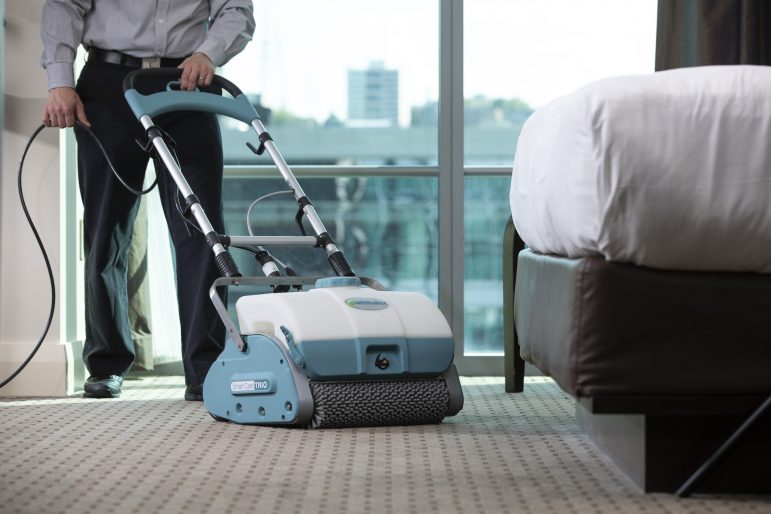Many facilities have hundreds or even thousands of square feet of carpet installed to enhance aesthetics, support indoor air quality (IAQ), control noise, and more. The way cleaning professionals approach carpet care and maintenance of soft flooring can have an impact on guest satisfaction, brand reputation, and the bottom line. Just as important is using the right equipment to conduct carpet care, from daily vacuuming to interim maintenance throughout the year.
By following carpet and equipment care best practices, facility managers can set their buildings and their teams up for success.
Cleaning Considerations for Carpet
Carpet, as with all floor coverings, requires consistent attention and cleaning to preserve its appearance. In some cases, carpet can last well beyond its warranty if it is correctly cared for. This helps facilities reduce replacement costs and the disruption associated with tear out and installation.
Facility managers, in-house cleaning teams, and building service contractors can enhance the look of carpet by implementing various strategies, including:
- Make carpet care a regular commitment – According to a 2020 survey conducted by The Harris Poll, the majority of people (93 per cent) say that dirty carpet would negatively impact their perception of a facility. The pandemic has brought the role of cleaning to the forefront and resulted in new concerns among the public. Regularly cleaning carpet not only helps remove spots and stains, but it also showcases to facility guests that an organization takes cleanliness seriously. Quiet machines also enable staff to carry out carpet care tasks during the day while people are present.
- Address stains with a variety of chemistry – Having a range of solutions on hand will make stain removal more effective. Different stains require different spotting agents in order to lift soils and even odors in some cases. For instance, oil and grease stains are not the same as red food-dye stains or organic stains. Look for formulations that will specifically target the composition of various types of stains, whether they are blood, coffee, paint or urine.
- Use equipment that enhances sustainability and productivity – The equipment acquisition decisions a facility makes can have a substantial impact on the success of a cleaning program. For example, vacuums with HEPA filters uphold good IAQ while low-moisture carpet cleaning machines help organizations save water. High-quality equipment can also enhance staff productivity, allowing them to address more carpet as well as focus on other important cleaning tasks. Many facilities opt for low-moisture systems because flooring dries more quickly (in about 30 minutes), which greatly reduces total time spent on carpet care and avoids disruptions for visitors.
Keeping Equipment in Working Order
When tools like vacuums and encapsulation machines are operating at peak performance, it greatly reduces downtime and keeps employees productive as they work through a variety of cleaning tasks. Checking equipment often and conducting the proper pre- and post-cleaning rituals can also limit the risk of costlier fixes or even premature replacement.
By following the best practices below, cleaning professionals can improve the lifespan of important carpet care essentials.
- Replace bags, filters and brushes as needed – When working with commercial vacuums, such as upright models, bags need replacing before they are entirely full. This is because as the bag becomes fuller, it negatively impacts machine performance and soil removal. Additionally, vacuum filters should be checked and replaced every three to six months to ensure it continues to effectively trap and remove smoke, mold, bacteria, pollen and other particles. Meanwhile, interim maintenance machines, like encapsulation systems, use brushes to agitate carpet cleaning chemicals and lift carpet pile. Thus, brushes need rotating on a regular basis, and replacement once they show visible signs of wear.
- Flush spray nozzles – Carpet cleaning systems use spray nozzles to effectively apply cleaning and stain removal solutions. Some are mounted within the machine and others are attached to separate tanks that employees carry as they work their way across carpeted areas. Whichever type of setup is used, it is important to frequently flush these nozzles with water to make sure they are spraying evenly. Uniform application upholds consistent carpet cleaning results throughout an entire facility.
- Keep the exterior of your machines clean – Cleaning professionals are increasingly completing their duties in the presence of building occupants and visitors. This means that equipment needs to look professional and well maintained. Wiping down machines, removing any visible scuffs, and cleaning and properly winding power cords after each use keeps equipment looking its best and further promotes an organization’s pride in its cleaning program.
Taking Care of Carpet Assets
A facility’s carpet and its cleaning equipment are both assets that require care and maintenance. Dirty carpet can leave a negative impression on guests and occupants, whether it be in a hotel, retail store, airport, long-term care facility or commercial office. Regular vacuuming and interim maintenance help to remove built-up soil and stains and uphold the color and appearance of carpet, as well as an organization’s commitment to cleanliness. Meanwhile, routinely checking on machines keeps them in good working order, so staff are always ready to perform carpet cleaning. These simple carpet and equipment care steps go a long way in protecting brand image and preserving customer satisfaction.
Joseph Bshero is the director of technical services with R.E. Whittaker Co., a family-owned carpet care system manufacturer celebrating 60 years in business in 2021 and the pioneers of the first commercial carpet encapsulation system. For more information about low-moisture encapsulation systems from Whittaker, visit whittakersystem.com.










